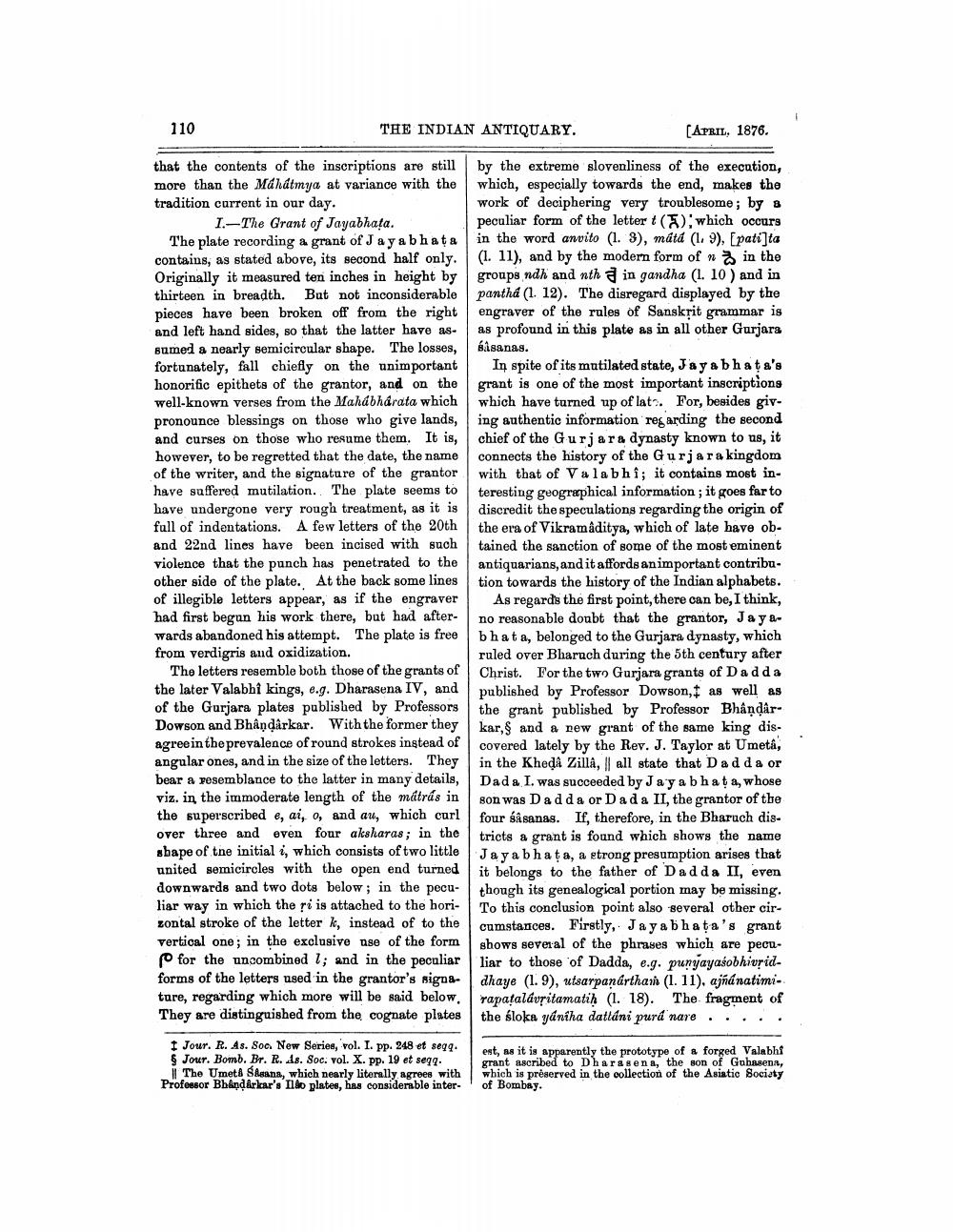________________
110
THE INDIAN ANTIQUARY.
(APRIL, 1876.
that the contents of the inscriptions are still by the extreme slovenliness of the execution, more than the Mahátmya at variance with the which, especially towards the end, makes the tradition current in our day.
work of deciphering very troublesome; by I.-The Grant of Jayabhata.
peculiar form of the letter t (), which occurs The plate recording a grant of Jay a bhata in the word anvito (1. 3), mátá (1.9), pati]ta contains, as stated above, its second half only. (1. 11), and by the modern form of n % in the Originally it measured ten inches in height by groups ndh and nth à in gandha (1. 10 ) and in thirteen in breadth. But not inconsiderable pantha (1. 12). The disregard displayed by the pieces have been broken off from the right | engraver of the rules of Sanskrit grammar is and left hand sides, so that the latter have as. as profound in this plate as in all other Gurjara sumed a nearly semicircular shape. The losses, sisanas. fortunately, fall chiefly on the unimportant In spite of its mutilated state, Jayabhata's honorific epithets of the grantor, and on the grant is one of the most important inscriptions well-known verses from the Mahabharata which which have turned up of lat. For, besides givpronounce blessings on those who give lands, ing authentic information regarding the second and curses on those who resume them. It is, chief of the Gurjara dynasty known to us, it however, to be regretted that the date, the name connects the history of the Gurjara kingdom of the writer, and the signature of the grantor with that of Valabhî; it contains most inhave suffered mutilation. The plate seems to teresting geographical information; it goes far to have undergone very rough treatment, as it is discredit the speculations regarding the origin of full of indentations. A few letters of the 20th the era of Vikramaditya, which of late have oband 22nd lines have been incised with suchtained the sanction of some of the most eminent violence that the punch has penetrated to the antiquarians, and it affords an important contribuother side of the plate. At the back some lines tion towards the history of the Indian alphabets. of illegible letters appear, as if the engraver As regards the first point, there can be, I think, had first began his work there, but had after- no reasonable doubt that the grantor, Jayawards abandoned his attempt. The plate is free bhata, belonged to the Gurjara dynasty, which from verdigris and oxidization.
ruled over Bharuch during the 5th century after The letters resemble both those of the grants of Christ. For the two Gurjara grants of Dadda the later Valabhí kings, e.g. Dharasena IV, and
published by Professor Dowson, I as well as of the Gurjara plates published by Professors the grant published by Professor BhandarDowson and Bhandarkar. With the former they kar, and a new grant of the same king disagree in the prevalence of round strokes instead of
covered lately by the Rev. J. Taylor at Umetá, angular ones, and in the size of the letters. They in the Kheda Zilla, || all state that Dadda or bear a resemblance to the latter in many details, Dada I was succeeded by Jay a bhat a, whose viz, in the immoderate length of the mátrás in son was Dadda or Dada II, the grantor of the the superscribed e, ai, o, and au, which curl | four så sanas. If, therefore, in the Bharuch disover three and even four aksharas; in the tricts a grant is found which shows the name shape of the initial i, which consists of two little Jaya bha ta, a strong presumption arises that united semicircles with the open end turned it belongs to the father of Dadda II, even downwards and two dots below; in the pecu- though its genealogical portion may be missing. liar way in which the ri is attached to the hori- To this conclusion point also several other cirzontal stroke of the letter k, instead of to the cumstances. Firstly, Jayabhata's grant vertical one; in the exclusive nse of the form shows several of the phrases which are pecu.
for the uncombined l; and in the peculiar liar to those of Dadda, e.g. punyayasobhivridforms of the letters used in the grantor's sign- dhaye (1.9), utsarpanárthan (1. 11), ajñanatimi. ture, regarding which more will be said below. rapatalávsitamatih (1. 18). The fragment of They are distinguished from the cognate plates the sloka yaniha dattáni purá nare .....
I Jour. R.As. Son New Series, vol. I. pp. 248 et seqq. § Jour. Bomb. Br. R. 18. Soc. vol. X. pp. 19 et seqq.
| The Umet SAsana, which nearly literally agrees with Professor Bhandarkar's Il&o plates, has considerable inter
ent, as it is apparently the prototype of a forged Valabhi grant ascribed to Dhardsena, the son of Gubasena, which is preserved in the collection of the Asiatic Society of Bombay.




